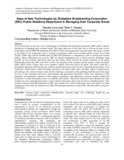Please use this identifier to cite or link to this item:
https://cris.library.msu.ac.zw//handle/11408/2656Full metadata record
| DC Field | Value | Language |
|---|---|---|
| dc.contributor.author | Masuku, Caven | - |
| dc.contributor.author | Dube, Tinashe V. | - |
| dc.date.accessioned | 2017-07-14T12:38:57Z | - |
| dc.date.available | 2017-07-14T12:38:57Z | - |
| dc.date.issued | 2017 | - |
| dc.identifier.issn | 2141-7024 | - |
| dc.identifier.uri | http://jetems.scholarlinkresearch.com/abstractview.php?id=2x8 | - |
| dc.identifier.uri | http://hdl.handle.net/11408/2656 | - |
| dc.description.abstract | The article focuses on the uses of new technologies by Zimbabwe Broadcasting Corporation (ZBC) public relations department in managing their corporate brand. The major objectives of the study was to find out the uses of new technologies used by ZBC PR department from 2013 to 2014 in managing their corporate brand. The study is related to the theme of the conference, since it focused on emerging trends such as mobile phone, E-mail, Face book, Twitter, What?s app and the Website used by ZBC PR department to communicate with its internal and external publics. These technologies were used by ZBC for disaster management after it faced economic challenges made possible by the economic melt-down faced by the country which affected the normal operation of the public broadcasting station like ZBC from 2013 to 2014. The merging of the computer and the internet created the digital public sphere where citizens share views instantly without restrictions across the globe. The study would use a postmodern approach to PR that focuses on PR as institutional process and its role in organisational discourses. Post modernism would enable to link knowledge and power, dis-sensus rather than consensus. Again it merged power and ideology, the concept of hyper reality and the challenge to rationality. Data gathering methods used in the study are face to face structured interviews, questionnaires and participant observation. These were subjected to both qualitative and quantitative methods of data analysis. Qualitative and quantitative research designed enabled the researchers to attain information closer to reliability and validity. Theoretical framework that informed the study includes two way communication theory, social cognitive dissonance theory and electronic colonialism theory. This research found out that PR department at ZBC uses multiple new media technologies and social media for brand management. The study also indicates how ZBC PR department practices excellent PR, with their publics using new technologies. | en_US |
| dc.language.iso | en | en_US |
| dc.publisher | Scholarlink Research Institute Journals | en_US |
| dc.relation.ispartofseries | Journal of Emerging Trends in Economics and Management Sciences;Vol. 8, No 2; p.:110-115 | - |
| dc.subject | Corporate brand | en_US |
| dc.subject | Corporation communication | en_US |
| dc.subject | Corporate image | en_US |
| dc.subject | New technology | en_US |
| dc.subject | Digital age | en_US |
| dc.subject | Excellent public relation public | en_US |
| dc.title | Uses of new technologies by Zimbabwe Broadcasting Corporation (ZBC) Public Relations Department in Managing their Corporate Brand | en_US |
| dc.type | Article | en_US |
| item.openairetype | Article | - |
| item.openairecristype | http://purl.org/coar/resource_type/c_18cf | - |
| item.grantfulltext | open | - |
| item.languageiso639-1 | en | - |
| item.cerifentitytype | Publications | - |
| item.fulltext | With Fulltext | - |
| Appears in Collections: | Research Papers | |
Files in This Item:
| File | Description | Size | Format | |
|---|---|---|---|---|
| Uses of New Technologies by Zimbabwe new (CAVEN AND TINASHE 2017).pdf | Full Text | 199.18 kB | Adobe PDF |  View/Open |
Page view(s)
888
checked on Dec 22, 2025
Download(s)
72
checked on Dec 22, 2025
Google ScholarTM
Check
Items in MSUIR are protected by copyright, with all rights reserved, unless otherwise indicated.



